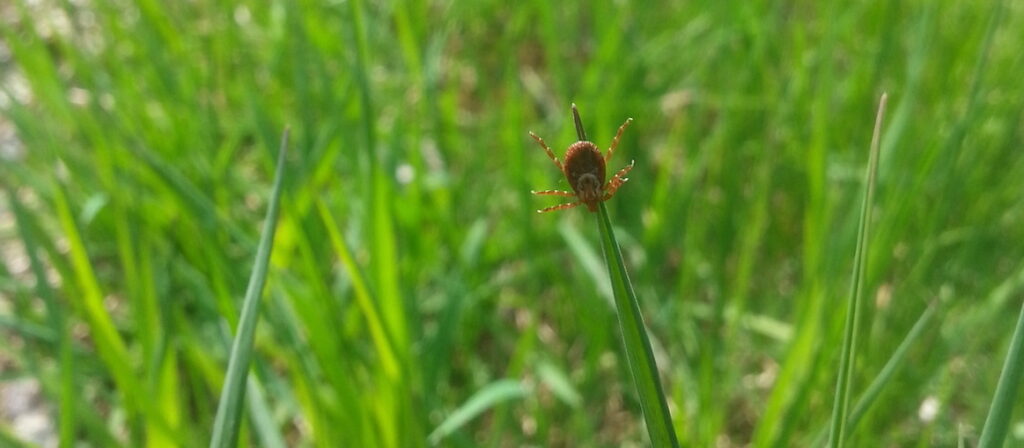SPRING IS IN THE AIR, AND SO ARE TICKS!
(A COMMON TICK Q&A)
Spring is finally here! Many pet parents are rejoicing, and for good reason: This season marks an end to the gloom of winter, bringing happiness, abundance, and warmer weather along with it. The last is usually synonymous with more time spent outside with pets, especially for us dog guardians. For lovers of the great outdoors, there is no greater pleasure than being out in nature with your four-legged pal. While it is tempting to frolic in the grass, and traipse through the brush, these activities may expose you and your companion to certain undesirable parasites: Ticks. You may have heard of them, but did you know that the risk of exposure to ticks is directly proportional to the temperature, and is therefore at its highest in the spring and summer months? In this article, we will attempt to shed some light on ticks in general, and how they can be identified, dealt with, and avoided. So, read on to find out the answers to many commonly asked questions, and for some additional information and facts you might have not known about these pests.
1. WHAT ARE TICKS?
Ticks are arachnids, which means that they are relatives of spiders. If you don’t believe us, the next time you see a tick, just count its legs! Ticks have eight legs, just like a spider does, distinguishing them from insects, which only have six legs. Ticks are parasitic, and they feed externally on the blood of their hosts.

2. WHY ARE TICKS DIFFICULT TO SPOT?
The difficulty in detecting ticks initially, especially on your pet, may be due to their rapid expansion. Ticks start out small, usually only a few mm, but they can quickly become “engorged” while feeding on their host’s blood, effectively doubling or tripling in size. So, it is no wonder that something originally that tiny is bound to go unnoticed in all that fur! Most guardians will only see or feel a tick by the time it has significantly grown.
3. WHERE DO TICKS COME FROM?
Ticks usually reside in long grass, brush, or shrubs. Remember how we mentioned that ticks have eight legs? Well, two of these legs (the extended front ones) are responsible for “grasping” the passing host so that they may crawl onto its body and latch on. So, any time you or your pet brush past any thick vegetation close to the ground, you may be unknowingly picking up some ticks!

4. HOW DO TICKS AFFECT DOGS?
At best, ticks will only cause irritation at the sites where they have attached to your pup, and when sufficiently engorged, will fall off on their own. However, if the infestation is severe, anemia may ensue. Ticks are also potential carriers of many diseases, the most well-known of which is Lyme disease. If left untreated, it can lead to serious damage to the nervous system, kidneys, and heart.

5. HOW CAN I AVOID CONTACT WITH TICKS?
As you have probably inferred from the previous answers, the best way to mitigate any tick encounters is to avoid crossing through the thickly vegetated areas in which they dwell. This should lower the risk of any ticks transferring onto your dog or yourself. You can also perform a thorough “check” after each and every outdoor adventure you and your canine companion may embark on. To do this, you can simply run a flea comb or your hands through your dog’s fur and check for any small bumps or irregularities. If you know that your dog will be spending a lot of time outdoors, potentially in tick territory, you may want to invest in some tick control products, which you can easily obtain from your vet or local pet supply shop.
6. HOW CAN I SAFELY REMOVE AN ATTACHED TICK FROM MY DOG?
When it comes to tick removal, your vet should always be the first choice. However, with that being said, you can safely remove any embedded ticks yourself, using gloves, tweezers, a disinfectant or antiseptic cream (for your dog), and rubbing alcohol. Using disinfected tweezers, clamp the tick as close to your dog’s skin as possible (without pinching your pooch), and pull it straight out without any jerking or twisting motions. Immediately after, drop the tick into a cup, container, or jar filled with enough rubbing alcohol to submerge it, as this will kill it immediately. Then, disinfect the site previously occupied by the tick on your dog’s body using
the dog-safe antiseptic solution or cream. Finally, re-disinfect your tweezers with rubbing alcohol, and do not forget to wash your hands, even if you were wearing gloves!
7. WHAT ARE THE SIGNS OF A TICK-BORNE DISEASE IN MY DOG?
Last but not least, do not forget to watch for any adverse symptoms displayed by your dog, especially after coming into contact with a tick. The signs you should look out for include but are not limited to fever, fatigue, loss of appetite, lameness, and swollen joints. If you do notice any of these symptoms in your dog, be sure to schedule an urgent trip to your vet, as tick-borne diseases are usually easier to treat the earlier they are diagnosed.

We hope that you have benefitted from this article, and that you and your pets have a wonderful time this spring, full of new adventures and precious memories, of course while maintaining all of the proper precautions and safety measures.While ticks are a nuisance, they should not deter you from getting outside with your best friend! This season, perhaps you could consider visiting us at GMAP to enjoy the beautiful scenery, and engage in some fun outdoor activities with our dogs as well.
Best regards,
The GMAP Team.

